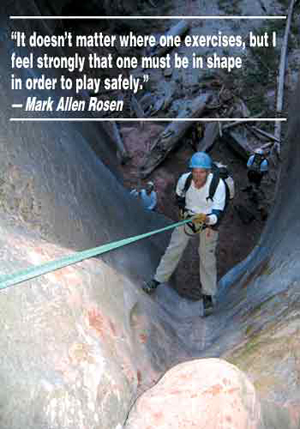Surgeon is avid climber in Utah hills, canyons
Fitness and safety are main concerns of orthopedist who is a certified canyon leader, climbing instructor, lifeguard.
 Climbing steep
slopes and rappelling into deep chasms might seem odd exercise for an
orthopedic surgeon, but Mark Allen Rosen, MD, considers
“canyoneering” a natural choice.
Climbing steep
slopes and rappelling into deep chasms might seem odd exercise for an
orthopedic surgeon, but Mark Allen Rosen, MD, considers
“canyoneering” a natural choice.
“It doesn’t matter where one exercises, but I feel strongly that one must be in shape in order to play safely,” Rosen told Orthopedics Today in a recent interview.
Rosen, 46, who was born in Anchorage, Alaska, has spent most of his life in the Salt Lake City area. A long-time runner and hiker, Rosen eventually gravitated toward climbing and canyoneering.
First dubbed “canyoning” in Europe, where the activity gained popularity about a decade earlier, canyoneering combines the skills of climbing, hiking and swimming in challenging its participants to traverse some of the most scenic but treacherous terrain.
Rosen is a certified canyon leader, climbing instructor and lifeguard, with fitness and safety his main concerns.
“I don’t have delusions of earning a living with these pursuits, but by becoming certified, I have gained knowledge that makes me safer in my journey and more valuable to the group in extreme situations,” he said.
Going vertical
While canyoneering is a methodical sport that requires patience and stamina, it certainly fits into the extreme category.
Climbing up or rappelling down heights of up to 500 feet in the canyons of Zion National Park in the Colorado plateau and slipping through slot canyons as narrow as 9 to 18 inches calls for experience, knowledge and preparation, Rosen said.
“If the rope is good, the anchor is secure, and your skills are refined, canyoneering can be pretty safe.”
Rosen leads about 15 to 20 trips a year as a canyon leader, including budding climbers from the area Boy Scouts. He starts the younger scouts, aged 12 to 13, on crags while the older scouts, 16 to 18 years old, can experience various canyons on the Colorado Plateau, including those in Zion National Park, the San Rafael Swell, Escalante National Monument, and the Glen Canyon National Recreation Area.
On a recent trip with the scouts to the top of Englestead Hollow, the group rappelled a 300-foot drop into the canyon. “I set the line, then checked everyone as they went over and, finally, I went over last,” Rosen said.
Physicians should stay fit
|
While safety is a major concern in canyoneering, fitness is just as necessary. Rosen’s fitness regimen includes running three miles three times a week, climbing stairs, and cycling about 17 miles twice a week.
Exercise of any kind can be equally beneficial, he said. “I enjoy exercising outdoors even in the winter but I have a neighbor who exercises with a trainer at the gym. When we do things together outdoors, he always pulls his share and then some and is in great shape.”
Rosen said he emphasizes the importance of maintaining good health through proper diet and exercise, and frequently tells his patients to lose weight and live healthier lifestyles. While he often promotes hiking and climbing, he recommends cycling and swimming for others, depending on their medical condition.
Physical fitness should be particularly important to physicians, he said, since they are the ones called on to tend to others in a time of need. He recalled an experience with Douglas Jackson, MD, when the two hiked the Grand Canyon from “rim to rim.” On the final uphill climb of a 26-mile journey, Jackson noticed an elderly woman struggling and was able to offer her the medical attention she needed. Jackson is chief medical editor of Orthopedics Today.
“Here we were just trying to drag ourselves up the last 1/4 mile to the finish, and Doug is still with it enough to recognize that someone is in trouble and to offer medical help.”
That moment solidified for Rosen the importance of physical fitness for sports medicine doctors. “If you are not in shape and can barely take care of yourself, you can be of no assistance to others,” he said.
